When in February 1552 Mikhail Bulgakov-Golitsa and Iwan Sielechowski crossed the borders of the Moscow state, the Tsar sent a welcoming retinue to fetch them. Ivan IV the Terrible also honored his princes with a royal gift and a question about their health. However, it was not the triumphal entry of the victorious leaders, but the return of the last living prisoners from the Orsha pogrom. This was probably not how they imagined him when, one summer morning 37 years earlier, they saw on the Dnieper the much weaker Polish-Lithuanian army.
At the turn of the 15th and 16th centuries, the Moscow state was going through the process of the so-called collecting Ruthenian lands, that is, the unification of Great Russian princes under a common scepter. Due to the vigorous actions of Ivan III (1462–1505) and his son Vasilii III (1505–1533), their rule quickly began to grow into the greatest political and military force in Eastern Europe.
The importance of Moscow at that time was already so great that even the countries of the German Reich took it into account. But the respect of such an important player in the international arena had nothing to do with resistance from the closest neighbor - Lithuania. Having in its possession ethnically Ruthenian lands the state of the great Lithuanian dukes was the main obstacle to the successful implementation of the Moscow "gathering" . This, of course, had to lead to further clashes not only with Lithuania, but also with Poland remaining in the personal union with it.
Short perpetual room
The fights were particularly intensified at the beginning of the 16th century. They were happening with varying luck, but in 1503 Lithuania had to hand over to the Muscovites a large part of the Smolensk land (excluding Smolensk itself) and the Duchy of Chernihiv and Severus.
However, it did not stop there and 5 years later another war broke out, in which the Lithuanian army was officially supported for the first time by reinforcements from the Crown under the personal command of King Sigismund I the Old. The only effect of these struggles was the so-called a perpetual peace which, fortunately for Lithuania, did not take away any more lands . It only confirmed Moscow's acquisitions to date, but probably hardly anyone believed in the durability of this agreement. The opponents only seemed to be waiting for the right moment to settle the age-old conflict.

The Battle of Orsza painting
The conclusion of peace by no means meant an end to fighting. Every now and then the borderland was on fire due to the Tatar clusters launched both by Vasyl, who, according to the chronicler, "harassed Lithuania with constant and various invasions," and by the Polish-Lithuanian side. The prince himself was also involved in a wide-ranging action of negotiating alliances, incl. with the German Empire, the Danes and the Teutonic Knights. The Jagiellonian side was not indebted in this matter. As historian Marek Gędek colorfully put it, "to temper the tsar's possessive plans", Sigismund I entered into an alliance with the Khan of the Crimean Tatars Mengli Giray - Vasyl's ally so far.
Soon, too, to the great duke's chagrin, the king's new allies launched a series of plundering raids into the southern parts of the Duchy of Moscow. When rumors of the alleged ill-treatment of his daughter (widow of King Alexander Jagiellon) at the Polish court reached the Russian sole ruler, it became clear that the "gathering" of the lands would have another stage.
In November 1512, confident in the power of his army, Vasyl III officially declared war on the Polish ruler - a peaceful eternity lasted 4 years.
The key to the Smolensk gate
After the declaration of war, however, no large-scale combat operations took place immediately. Winter was fast approaching, and at this time of the year there was hardly any fight. The Muscovites limited themselves only to sending out traffic groups in the direction of Orsza, Druck, Velikiye Luki and Kiev with the task of disrupting Lithuanian preparations for the war.
Only with the first spring thaws, the entire, probably 80,000 army of Vasyl under his personal command, went into battle, closing the siege of Smolensk with a ring . As experts on the subject point out, such a choice was not a coincidence. The local fortress, located on the upper Dnieper, guarded the critical passage between Lithuania and Moscow - known as the Smolensk Gate. Whoever was in charge of this land gap between the Daugava and the Dnieper was gaining a strategic advantage over the enemy. And the capture of Smolensk by the Moscow prince would open a free path for his troops to Vilnius - emphasizes the historian Grzegorz Błaszczyk.
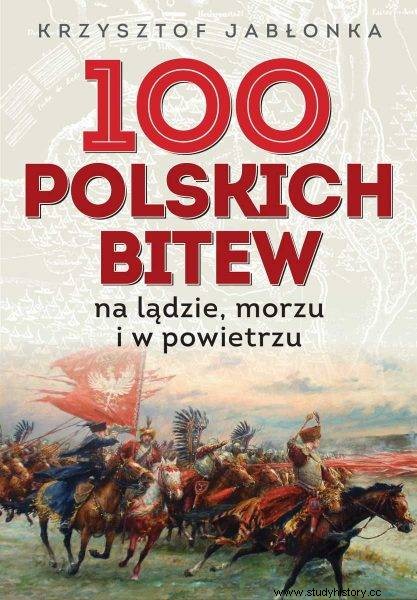
The text was created, among others based on Krzysztof Jabłonka's book “100 Polish Battles. On land, sea and in the air ”, which has just been released by the Zona Zero publishing house.
However, despite solid preparations, Wasyl did not manage to get a fortress, perfectly prepared for defense, about which the chronicler Maciej Stryjkowski wrote:"Smolensk castle also with its natural and natural places and walls, battlements, with oak chambers carved and well decorated with earth ...". The siege lasted almost two months. After all, the Moscow army had to give up. Not for long. Smolensk was too important to ignore attempts to win it after the first failure.
However, the second attempt to capture the fortress in August 1513 also ended in failure. What is more, the invaders were also rejected, with the general participation of the crown mercenaries, from the besieged Połock and Vitebsk at the same time, and suffered defeats at Orsha.
A real gallop of failures meant that the Grand Duke of Moscow was even close to signing another peace. Fortunately (for the prince, of course), Emperor Maximilian I offered Moscow a joint attack on the Jagiellonian state. Only the self-leaseholder from the Kremlin seemed to be waiting for this to happen. At the beginning of 1514, the Habsburg monarchy and the Muscovite principality signed an alliance agreement under which Moscow was to receive assistance in capturing the rebellious Smolensk, as well as Kiev, Vitebsk and Połock. In this situation, Wasyl broke off the peace negotiations with Poland and Lithuania that had begun earlier.
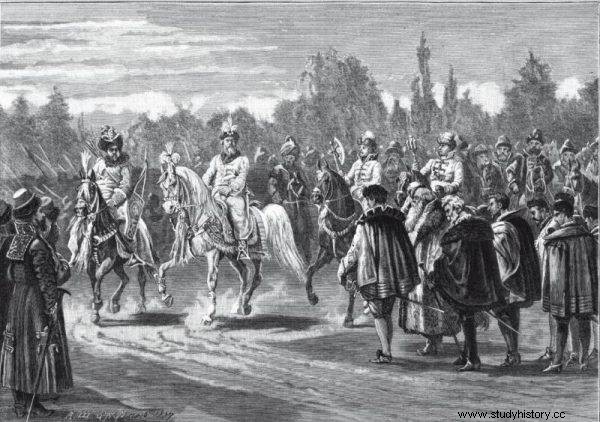
Vasyl III Ivanovich
The relentless Smolensk target was once again targeted. This time the great prince prepared the campaign even more carefully. As part of the imperial support, he received, among others the possibility of recruiting many specialists from the West. According to the chronicler Decius, Vasily III "hired Germans and Italians to serve him, who, oblivious to their faith, prepare the destruction of Christians, build various siege guns, train the worst rogues in skills they know and take part in crimes themselves. ”
In mid-April 1514, the Moscow army again approached the fortifications of Smolensk. Despite the enormous numerical advantage of the enemy, the city bravely repelled the attacks of the Muscovites for two months. The situation of the defenders changed for the worse at the end of June, when forces headed by Vasyl III himself at the head of the fortress. Managed massive fire from 300 cannons did their job. The damage and losses among the defenders had to be enormous. And when there were also rumors about the planned slaughter of the inhabitants in the event of further persistent resistance, the decision of the Smolensk voivode, Yuri Solłohub, who was commanding the defense, could have been only one - capitulation. The fortress was surrendered on July 30, and the next day a great duke triumphantly entered it. The road into the Ruthenian lands under Lithuanian rule was open.
All roads lead to ... Orsha
Following Smolensk, other cities surrendered:Mścisław, Kryczew and Dubrowna. However, Vasyl's offensive actually ended there. After all, he conquered the coveted Smolensk, so he did not intend to rush into further actions. With his main forces he headed only towards Orsha, manned by the Lithuanian crew, farther west. At the same time, he did not expect that the late relief of Sigismund I was also going in this direction from Minsk.
The Polish ruler carried with him painstakingly collected, but substantial and modern for those times strength. Historians estimate the size of his army at around 30,000. people with a large share of mercenary troops and numerous artillery. Having reached Berezina at the end of August, the king stayed with a 5,000-year-old reserve in Borisowo.
The main forces under the command of the Grand Hetman of Lithuania Konstanty Ostrogski - "a prince from the Rurykowicz family, who could compete with the princes of Moscow for their principality", as Krzysztof Jabłonka, a history enthusiast, writes about him in the book 100 Polish battles on land, sea and in the air - crossed the river. The first clashes with the Moscow climbs also took place there. Only then did Prince Ivan Czeladnin, commander-in-chief of Vasilii III's army, really reach the scale and scale of the actions of the Jagiellonian army. Therefore, he ordered his forces to retreat to the left bank of the Dnieper and to concentrate them in its bend on the road from Orsha to Dubrovna.

Zygmunt I Stary
As historian Mirosław Nagielski emphasizes, " Czeladnin's plan was simple:he wanted to attack the Polish-Lithuanian army during the crossing , pull it to the left bank of the Dnieper and - numerically - surround it and destroy it. " The implementation of this plan seemed to be extremely easy to implement, the more so that Czeladnin had a numerical advantage (40-60 thousand people, but mainly poorly armed pomiestna cavalry, which can be compared to some extent to the Polish mass start) and controlled the only two permanent crossings on the river. Thus, there was nothing else but to wait for Ostrogski's forces. It soon turned out that this inaction was to become the hallmark of the actions of the Moscow commander.
After barrels to the target
Meanwhile, in the morning of September 7, the forces of the Lithuanian hetman reached Orsha. Having figured out the position of the enemy troops, Ostrogski decided not to cross the Dnieper under the nose of Czeladnin - and thus thwarted the essential part of his plan to destroy the Jagiellonian troops. According to a colorful description of Marcin Bielski:"our willingness to [battle] left us on the shore a few thousand light people, so that they appeared in Moscow, in another place a bridge made of trees and troughs, sprung and cannons, and on foot to the other side of Niepru they crossed".
The other place was the vicinity of the village of Paszyno located slightly upstream. However, as Krzysztof Jabłonka notes in his book - based on the painting depicting the Orsha battle created shortly after the battle - the crossing was made over the bridge with related wine and beer barrels, which were full of Hetman's camps . This thesis is also accepted by most historians today.
What a lamentation in the camp must have been when countless streams of red and golden liquors were poured from the barrels for the needs of war. Their number is unknown. Suffice it to say that the royal sappers led by the burgher from Żywiec, Jan Baszta, had enough to build two bridges, over which most of the forces, along with artillery, traveled on the night of September 7-8. The light ride, on the other hand, swam.
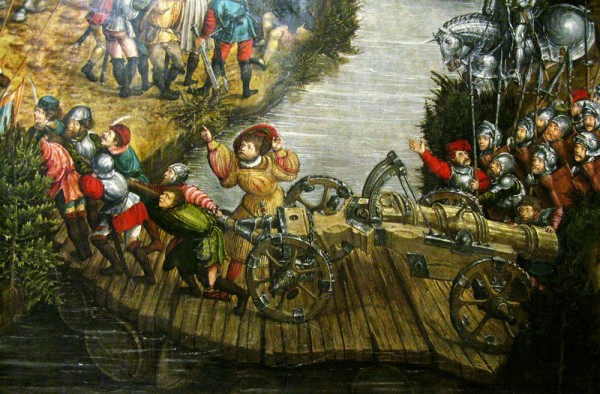
Polish artillery crossing on an improvised pontoon bridge, boats and barrels visible under the boards
Despite the breaking of one of the bridges, no serious losses were carried out and around 9 a.m. the entire Polish-Lithuanian army found itself on the eastern bank of the Dnieper. Interestingly, Czeladnin realized that the opponent was going to cross the Dnieper elsewhere, but again he watched it idly. The commanders present with him insisted that he should pin Ostrogski's troops on the banks and push them back into the currents of the river. However, Czeladnin was to answer:
if we defeat this part of the royal army, then another half of them will remain, to which the second uphas could join, what could we do with greater danger, therefore better let's wait until the army clears through everything, because such is our power and without a doubt, and with a little work, their army will either wipe out their army, or they are surrounded to Moscow like cattle and chase them with the king with their puhs, and therefore, what is at stake, we will easily take control of Lithuania.
Meanwhile, the Lithuanian hetman calmly developed his ranks according to the "old Polish device". In the center, there was a heavy cavalry cavalry, including Polish and Lithuanian checkpoints at the front, and similarly divided general troops at the rear. On the wings, three troops of auxiliary troops were formed, on the left Lithuanian, on the right Polish, consisting of light cavalry, mainly Rack - i.e. hussars.
Most of the infantry and a large part of the artillery were deployed between the chief troops. The rest of them, however, took over the positions even further to the right of the Polish auxiliary units. It is there, as Krzysztof Jabłonka writes, "over the ravine leading straight to the Dnieper, a" fiery people ", armed with arquebuses, arquebuses and falconets, developed . Hidden above them, at the edge of the ravine, the most dangerous weapon, mighty bronze cannons, was placed. "
At the same time, Chelyadnin, again idly waiting for the development of events, sent only skirmishers ahead of his own group. Only around 2 p.m. did he decide that the battle should begin. "Moscow struck the trumpets, struck the drums, melted the banners and flags on Lithuania with a boom," wrote Maciej Stryjkowski years later.
Pogrom
Bulgakov-Golitsa's right-hand regiment was the first to attack the Lithuanian auxiliary troops. The proud prince hoped to quickly break the enemy's light banners and flank the entire Ostrogski's army. The latter, however, knowing that the Lithuanians could succumb to the majority of Muscovites, ordered the attack of the Polish troop of the Supreme Court Hetman, Wojciech Sampoliński (there are also opinions that he himself decided it).
His hard cavalry, ignoring the arrows of the Moscow horse archers, circling around as if galloping in front of the Lithuanian head troop during a parade, struck some victories by the Ruthenians from the right-hand regiment. The crushing pressure of the coppers shook Golica's strength, but he kept his position. The fight was fierce, but eventually the Muscovites were outnumbered. The Poles and Lithuanians began to slowly retreat under the cover of the infantry and artillery, which cooled the aspirations of the princes' troops with a massive fire. However, the situation was becoming dangerous and the Jagiellonian forces were in fact in danger of being outflanked.
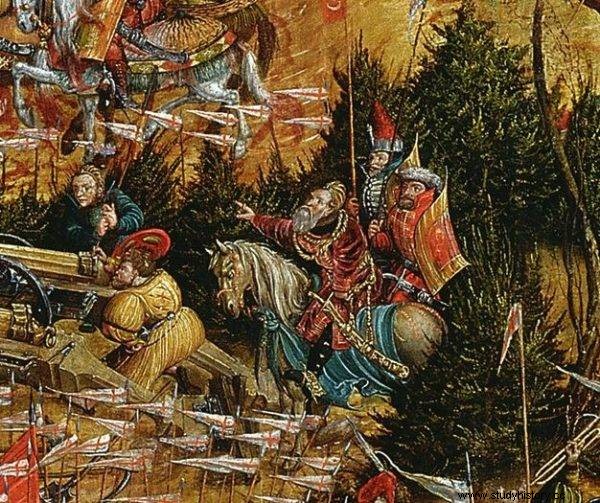
Konstanty Ostrogski
Realizing the horror of the battle that had just begun, Ostrogski led his Lithuanians from his chief troop to support Sampoliński.
Here is our victory triumh ready, / Already niepriatel mdlejet, therefore my brothers / Normal bravery renewed at this happy moment. / Tepir budte mużami, tepir in a brave body, / Let everyone arouse courage when you are enemies / Szyki deceive, and God himself stands on our side, / Already the tepir from Heaven gives us a defense, / Now all follow me boldly, / And in the bravery of famous fathers, be considered sons. / This I will put my fame before you, / And in the first of the enemy I will bleed the saber
- was to call the Grand Hetman, encouraging his troops to fight. Their strike completely surprised the Moscow cavalry, which began to give up the field, and after a while they started to run away - "to the hidden satisfaction of Czeladnin" - as Krzysztof Jabłonka writes in his book. For it was known everywhere that the leaders did not like each other and that they had personal scores.
At that time, the left-hand regiment of Prince Andrei Obolensky attacked the right wing of Ostrogski's army. This charge, however, was carried out on a smaller scale, and soon the Polish forces not only stopped the Moscow onslaught, but also proceeded to counterattack. And this despite the fact that the forces of Prince Temki-Rostowski's regiment entered the battle.
But what the surprise of the Moscow leaders must have been when the Poles suddenly turned back and, every horse jumped out, moved towards the Dnieper, simulating an escape. Czeladnin decided that this was a real retreat, and in order to catch the crossing on the river as soon as possible and cut off the escape route for Ostrogski's forces, the grand regiment threw into the fight. However, before his soldiers clashed with the enemy, the units of the left hand regiment encountered a bloody surprise. Here is an avalanche of lead and stones on the advancing Moscow banners. This made itself felt by the previously hidden "fiery people". Polish shooters and artillerymen worked like boiling water to fire as many volleys as possible. As we read in the book 100 Polish Battles ... :"Each shot was accurate, and some killed twice (...) The stone ball killed Prince Oboleński. Temko Rostowski, as well as most of the commanders and boyars, died soon. Panic broke out.
Seeing what was happening, the Polish auxiliary troops turned back and launched a violent attack on the shocked Ruthenians. A part of the Polish general unit under the command of Janusz Świerczowski, the starost of Trembowla, joined the attack. As a result of such a massive strike, the left-hand regiment lost any combat value. His survivors fell into the great regiment sent by Czeladnin, which caused confusion in his ranks as well. Not only that, when the Muscovites were still trying to organize the defense, Hetman Ostrogski with the Lithuanian commander arrived like a hurricane on the right.
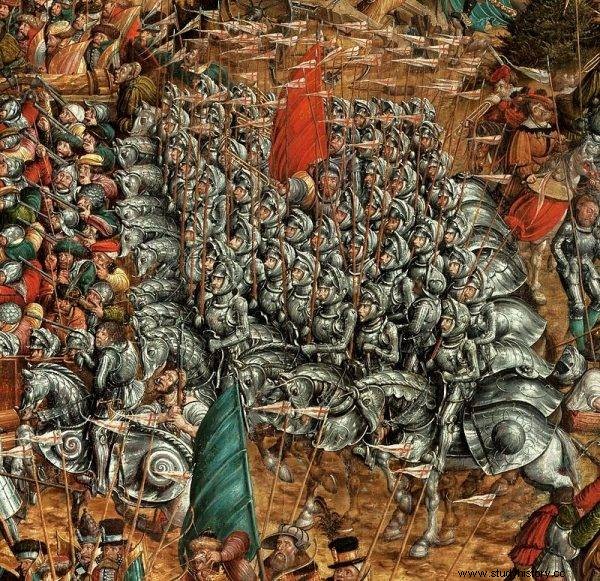
Heavy Driving Division
In the face of this strike, the great regiment turned out to be powerless, and seeing the defeat of the left-hand regiment, "frightened by its escape, and more daringly supported by our hand and shotgun, for the other, scattered towards it through the mountains, pits, forests, run and run , already as from a lost battle; our fleeing men struck, hacked, and struck; for a few miles, the fields, the mud, the forests of the slaughtered bodies were full, and so was great power of horses, especially at Kropiwna, a muddy river with sad banks of the river, four miles from the site of the battle; where so many people and horses stayed until the water broke in it and slowed down, and people drank our bloody water with their helmets out of thirst ", wrote Marcin Bielski, an almost witness to these events.
The defeat was coming in great strides. Czeladnin, however, did not lose heart. From the hill he commanded, he could clearly see what was happening on the battlefield, and he was convinced that Ostrogski had already used all his strength. Putting the last hope of victory in this, at the head of the so far not involved parts of the front guard regiment and the entire rear guard, he started the decisive charge. However, when the mass of Ruthenians was already gathering momentum, the Jagiellonian reserve forces stood in their way like a wall - the Lithuanian troop of Jerzy Radziwiłł "Hercules" and the rest of the Polish general Świerczowski unit supported by the forces of Grand Hetman.
The dense ranks of Poles and Lithuanians "plunged into Moscow ranks, cutting them in half. Each of these parts, circled and compressed, gave up separately. The journeyman and his staff went into captivity, from which many did not escape "- we read in 100 Polish battles .. . Around 6 p.m., the killing of the Moscow refugees began, which lasted until midnight. On the other hand, those who managed to escape from under the Jagiellonian blades, mostly found death in nearby rivers and swamps.
The next day, a few groups took refuge behind the fortifications of Smolensk, where the news of the victory was awaited in vain by Vasyl III. Instead, he had to accept that, quoting Krzysztof Jabłonka:"on the battlefield of Orsza, the Moscow Middle Ages collided with the Jagiellonian Renaissance", which resulted in several thousand bloody losses of his army and the captivity of many commanders, of whom only two after almost 40 years of POW misfortune returned to Moscow.
